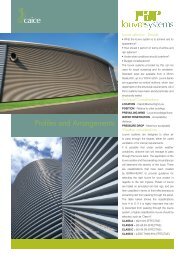CAICE Attenuator
CAICE Attenuator
CAICE Attenuator
Create successful ePaper yourself
Turn your PDF publications into a flip-book with our unique Google optimized e-Paper software.
Duct Line<br />
<strong>Attenuator</strong> casings are produced on the Duct Line shown opposite, which comprises<br />
four elements, de-coiling, flanging, folding and assembly. Manufacturing instructions are<br />
fed directly to the machine for each casing, and labels are printed locally for each part<br />
with bar codes to enable easy identification at later stages of production.<br />
The de-coiler holds seven coils of galvanised sheet steel, each weighing up to three<br />
tonnes. The width of each coil relates to the finished length of the attenuator casings,<br />
and we therefore have seven standard casing lengths that are available. This machine<br />
de-coils the steel for a casing, cuts it to length, notches it and roll-forms a Pittsburgh<br />
seam for subsequently joining the two ends of the sheet into a case.<br />
The sheet is then fed through the flanging machine, which roll-forms either a 20 or<br />
30mm profile flange onto each edge of the sheet, making the flange an integral part of<br />
the case. Profile flanges are compatible with MEZ, DOBY or METU flanging systems.<br />
The folder then takes the sheet and folds it, and finally it is assembled by closing the<br />
Pittsburgh seam to form an airtight joint, and fitting flange corners to make the finished<br />
casing.<br />
Because the entire width of a coil is used to produce a casing, material wastage is less<br />
than 5%, which occurs mostly at coil ends as the material is fed on and off the machine.<br />
Expanded Metal (XPM) Line<br />
Facings for attenuator splitters and linings are produced on an expanded metal decoiler.<br />
Manufacturing instructions are fed directly to the machine, which de-coils and<br />
cuts each sheet to length and at the same time bonds fibre glass tissue to the XPM.<br />
The sheets are then taken to a guillotine for cutting to the correct size for each part.<br />
Nesting software is utilised when the manufacturing instructions are compiled to ensure<br />
parts are cut economically from each sheet, keeping wastage below 20%. Any sizable<br />
pieces of scrap are also kept for later use to further reduce material wastage. Labels are<br />
again applied to each part to enable easy identification at later stages of production.<br />
Splitter Line<br />
All the frame parts for splitters are produced on the splitter line shown opposite, which<br />
comprises de-coiling, roll-forming and folding. Again manufacturing instructions are fed<br />
directly to the machine and labels are applied locally to the parts for easy identification.<br />
The de-coiler and roll-forming machine is over thirty metres long and holds six coils of<br />
galvanised sheet steel, each weighing up to two tonnes. The width of each coil relates<br />
to the finished width of the splitter parts. The steel for each part is de-coiled, cut to<br />
length, notched and the edges are roll-formed into a rigid channel, which will retain the<br />
XPM splitter facing. The ends of each part are then folded to enable them to be joined.<br />
Assembly Line<br />
All the parts finally come together on the attenuator assembly line. Splitter frames are<br />
joined, mineral wool is packed into the frames and the XPM facings are fitted to<br />
complete the splitters.<br />
<strong>Attenuator</strong> casings are then fitted with splitters and the finished product is then labelled,<br />
wrapped and packed onto pallets for dispatch.<br />
www.caice.co.uk<br />
<strong>CAICE</strong> <strong>Attenuator</strong> Brochure<br />
29
















